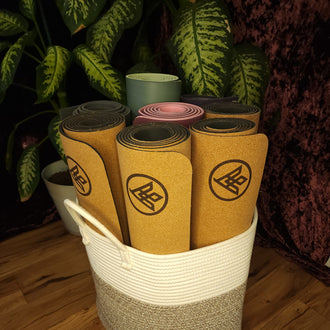Supta (Reclining)
Jack UtermoehlShare
Supta is a Sanskrit term meaning “reclining” or “lying down.”
In the context of yoga, it describes postures performed while lying on the back.
Supta poses are often grounding, restorative, and introspective. They provide an opportunity to surrender effort and allow the nervous system to shift into rest and repair mode.
Though gentle in appearance, supta poses can be deeply effective for both physical release and energetic integration.
Etymology and Meaning
Sanskrit Spelling: सुप्त
Root Word: "Supta" (to lie down, to sleep, to rest)
Translation Variations: Reclining, resting, supine, passive
Pronunciation: Supta [SOOP-tah]
Supta indicates a reclined or horizontal version of a pose, allowing for deep release, stillness, or introspective refinement.
Common Supta Postures
- Supta Baddha Konasana: Reclined Bound Angle Pose
- Supta Padangusthasana: Reclined Hand-to-Big-Toe Pose
- Supta Virasana: Reclined Hero Pose
- Supta Matsyendrasana: Reclined Spinal Twist
These poses are frequently practiced in restorative, yin, and cool-down sequences to integrate and harmonize energy.

Explore Our Full Collection
Discover all the yoga essentials and accessories you need to enhance your practice. Shop now and elevate your yoga practice.
Shop NowSymbolism and Energetics
Element: Earth - stability, grounding, containment
Chakra Connection: Muladhara (root chakra) and Svadhisthana (sacral chakra)
Energetic Quality: Cooling, calming, receptive
Practical Application
In Yoga Practice
- Use supta poses to begin or end your sequence with intention and stillness
- Pair with longer holds or props for restorative and nervous system recovery
- Explore breath awareness in reclined positions to refine pranic sensitivity
In Daily Life
- Incorporate supta poses as part of evening practices or before sleep
- Use restorative supta shapes when feeling overstimulated or anxious
- Support your body in stillness to listen to deeper emotional or energetic layers
Quotes and Wisdom
"Rest is not a break from practice. It is the practice itself."
"In supta, we learn to let the earth hold what we can no longer carry."
Modern Relevance
In today's world of chronic busyness and overstimulation, supta poses offer an invitation to pause.
They allow for repair without withdrawal, softness without collapse. By lying down with awareness, we can recalibrate our system, connect to the breath, and integrate the effects of more active practices.
Supta postures remind us that stillness is not passive; it is a powerful form of listening and healing.
Related Concepts
Viparita: Inverted or reversed postures, often integrated with supta forms
Pratyahara: Withdrawal of the senses, often deepened in supta postures
Yin Yoga and Restorative Yoga: Styles where supta poses are foundational
How to Work with Supta
Mindset: Practice surrender and presence, allowing yourself to be held
Actions: Use blankets, bolsters, or cushions to make supta postures supportive and therapeutic
Reflection: Ask, “What part of me needs rest, and can I let it be supported?”
Suggested Reading
- Relax and Renew by Judith Hanson Lasater
- The Therapeutic Yoga Kit by Cheri Clampett and Biff Mithoefer
- Yin Yoga by Bernie Clark
Conclusion
Supta reminds us that rest is not a weakness. It is a skill and a necessity.
These postures allow the body to yield, the breath to deepen, and the mind to soften. In reclining, we do not retreat, we return to ourselves.






